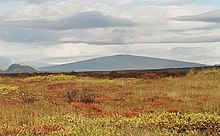Shield volcano

A shield volcano is a large volcano with shallow-sloping sides.
Characteristics
The name derives from a translation of "Skjaldbreiður", an Icelandic shield volcano whose name means "broad shield", from its resemblance to a warrior's shield.
Shield volcanoes are formed by lava flows of low viscosity — lava that flows easily. Consequently, a volcanic mountain having a broad profile is built up over time by flow after flow of relatively fluid basaltic lava issuing from vents or fissures on the surface of the volcano. Many of the largest volcanoes on Earth are shield volcanoes. The largest in terms of area covered is Mauna Loa of Hawai'i; the tallest measured from its base under the ocean, however, is Mauna Kea of Hawai'i. All the volcanoes in the Hawaiian Islands are shield volcanoes.
Geographical extent
Shield volcanoes can be so large that they are sometimes considered to be a mountain range, such as the Ilgachuz Range and the Rainbow Range, both of which are located in Canada. These shield volcanoes formed when the North American Plate moved over a hotspot similar to the one feeding the Hawai'ian Islands, called the Anahim hotspot. Shield volcanoes can be found in many places around the world, including Australia, Ethiopia, and the Galapagos Islands. The Piton de la Fournaise, on Reunion Island, is one of the most active shield volcanoes on earth, with one eruption per year on average.
Examples


- Mount Edziza volcanic complex (British Columbia, Canada)
- Mauna Kea (Hawai'i, US)
- Mauna Loa (Hawai'i, US)
- Ilgachuz Range (British Columbia, Canada)
- Rainbow Range (British Columbia, Canada)
- Itcha Range (British Columbia, Canada)
- Kilauea (Hawai'i, US)
- Menengai (Menengai, Kenya)
- Medicine Lake Volcano (California, US)
- Lunar dome (Moon)
- Mount Moulton (Marie Byrd Land, Antarctica)
- Mount Andrus (Marie Byrd Land, Antarctica)
- Mount Okmok (Umnak Island, Alaska, US)
- Indian Heaven (Washington, US)
- Mount Warning (or the Tweed Volcano), (New South Wales, Australia)
- Verkhovoy (Kamchatka, Russia)
- Olympus Mons (Mars)
- Level Mountain Range (British Columbia, Canada)
- Lord Howe Island (Pacific Ocean, Australia)
- Mount Sanford (Alaska, US)
- Mount Elgon (Uganda/Kenya)
- Three Fingered Jack (Oregon, US)
- Kohala (Hawaii, US)
- Mount Berlin (Antarctica)
- Queen Mary's Peak (Atlantic ocean)
- Erta Ale (Afar Region, Ethiopia)
- Mount Terror (Ross Island, Antarctica)
